I have a same problem -- communication between a C#/Python app and a Java app on windows using named pipes:
We have example of Client Code written on Java, but in line String echoResponse = pipe.readLine(); tread waits forever.
try {
// Connect to the pipe
RandomAccessFile pipe = new RandomAccessFile("\\\\.\\pipe\\testpipe", "rw");
String echoText = "Hello word\n";
// write to pipe
pipe.write ( echoText.getBytes() );
// read response
String echoResponse = pipe.readLine();
System.out.println("Response: " + echoResponse );
pipe.close();
} catch (Exception e) {
// TODO Auto-generated catch block
e.printStackTrace();
}
Solution of problem:
I have a ServerPipe code written on Python from here Example Code - Named Pipes:
and run its on Python 2.6.6
from ctypes import *
PIPE_ACCESS_DUPLEX = 0x3
PIPE_TYPE_MESSAGE = 0x4
PIPE_READMODE_MESSAGE = 0x2
PIPE_WAIT = 0
PIPE_UNLIMITED_INSTANCES = 255
BUFSIZE = 4096
NMPWAIT_USE_DEFAULT_WAIT = 0
INVALID_HANDLE_VALUE = -1
ERROR_PIPE_CONNECTED = 535
MESSAGE = "Default answer from server\0"
szPipename = "\\\\.\\pipe\\mynamedpipe"
def ReadWrite_ClientPipe_Thread(hPipe):
chBuf = create_string_buffer(BUFSIZE)
cbRead = c_ulong(0)
while 1:
fSuccess = windll.kernel32.ReadFile(hPipe, chBuf, BUFSIZE,
byref(cbRead), None)
if ((fSuccess ==1) or (cbRead.value != 0)):
print chBuf.value
cbWritten = c_ulong(0)
fSuccess = windll.kernel32.WriteFile(hPipe,
c_char_p(MESSAGE),
len(MESSAGE),
byref(cbWritten),
None
)
else:
break
if ( (not fSuccess) or (len(MESSAGE) != cbWritten.value)):
print "Could not reply to the client's request from the
pipe"
break
else:
print "Number of bytes written:", cbWritten.value
windll.kernel32.FlushFileBuffers(hPipe)
windll.kernel32.DisconnectNamedPipe(hPipe)
windll.kernel32.CloseHandle(hPipe)
return 0
def main():
THREADFUNC = CFUNCTYPE(c_int, c_int)
thread_func = THREADFUNC(ReadWrite_ClientPipe_Thread)
while 1:
hPipe = windll.kernel32.CreateNamedPipeA(szPipename,
PIPE_ACCESS_DUPLEX,
PIPE_TYPE_MESSAGE |
PIPE_READMODE_MESSAGE
|
PIPE_WAIT,
PIPE_UNLIMITED_INSTANCES,
BUFSIZE, BUFSIZE,
NMPWAIT_USE_DEFAULT_WAIT,
None
)
if (hPipe == INVALID_HANDLE_VALUE):
print "Error in creating Named Pipe"
return 0
fConnected = windll.kernel32.ConnectNamedPipe(hPipe, None)
if ((fConnected == 0) and (windll.kernel32.GetLastError() ==
ERROR_PIPE_CONNECTED)):
fConnected = 1
if (fConnected == 1):
dwThreadId = c_ulong(0)
hThread = windll.kernel32.CreateThread(None, 0,
thread_func, hPipe, 0, byref(dwThreadId))
if (hThread == -1):
print "Create Thread failed"
return 0
else:
windll.kernel32.CloseHandle(hThread)
else:
print "Could not connect to the Named Pipe"
windll.kernel32.CloseHandle(hPipe)
return 0
if __name__ == "__main__":
main()
After server have start you can use slightly modified version of the Java Client code:
try {
// Connect to the pipe
RandomAccessFile pipe = new RandomAccessFile("\\\\.\\pipe\\mynamedpipe", "rw");
String echoText = "Hello world\n";
// write to pipe
pipe.write(echoText.getBytes());
//String aChar;
StringBuffer fullString = new StringBuffer();
while(true){
int charCode = pipe.read();
if(charCode == 0) break;
//aChar = new Character((char)charCode).toString();
fullString.append((char)charCode);
}
System.out.println("Response: " + fullString);
pipe.close();
}
catch (Exception e) {
// TODO Auto-generated catch block
e.printStackTrace();
}
It works well in NetBeans 6.9.1.


